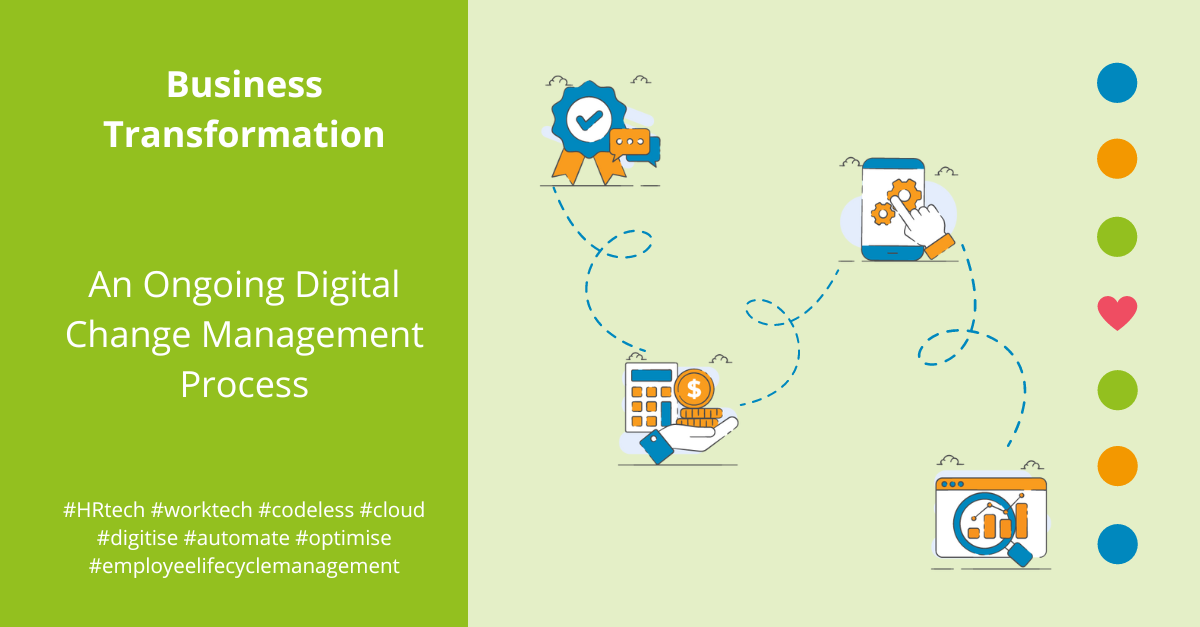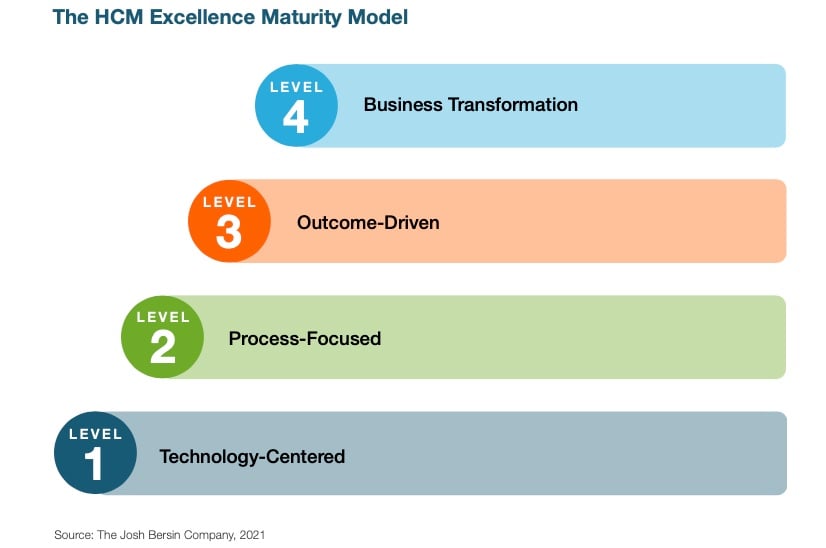Has the way your organisation does business changed recently? In some ways, that was a rhetorical question, because change is the only constant. Anyone running or working in a business knows that this decade has already brought so many changes to the way we work that many are finding it hard to keep up. Given that, the next question (not a rhetorical one this time) is - how is your business managing digital change management and transformation in the workplace? In this week's HR Blog we explore these topics through the lens of the Human Capital Management/HR Software maturity model.
Business Transformation Versus Change Management
Before we dive into the HCM/HR Software maturity model, let's take a quick look at the difference between business transformation and change management. According to Consultancy.me, the difference is as follows:
-
Business transformation: The process of business transformation begins by comparing the present with the future and analysing where your business stands now, and where it wants to be in the future. Having identified new opportunities and risks, a business transformation plan helps organisations adjust to the changing external environment or demand in the market, and charts a course from 'here' to 'there.' This is particularly relevant in the context of how the business wants (and needs) to transform, not just to survive, but to thrive. To be successful, business transformation requires foresight, strong decision-making skills, and change management to enable the transition’s objectives.
-
Change management: Change management allows organisations to be in a constant phase of evolution, removing barriers to change and keeping Employees productive and motivated during the process of change. A successful change management strategy requires effective communication between Management and Employees, and an effective knowledge transfer approach so that Employees can adopt to new ways of working. Change management enables a solid and successful transformation by explaining why the change is necessary, and then supports Employees to make that change effectively. Helping Employees re-skill is also a part of the change management process.
The Human Capital Management Excellence Model
According to Bersin's 'The Definitive Guide: HCM Excellence,' Human Capital Management transformation is rarely a linear progression. For example, an issue discovered during prototyping may require doing additional design work. Or, when the business environment changes midway through an implementation project (take the pandemic as an example), the plan, strategy, and success measures (as well as staffing) will need to be reconsidered and reworked to match the changing circumstances. The Guide defines the six phases of transformation in the HCM/HR Software lifecycle as follows:
-
Plan: Determine the vision, objectives, and approach; assemble a team; identify key partners; and establish work procedures, timelines, and success measures.
-
Design: Design key transactions that will define the aspired end-to-end experience, rethink roles, data, the processes involved, and even organisational structures.
-
Prototype: Build and configure the initial version of the HCM/HR system, and then integrate it within the company’s broader technology ecosystem.
-
Test: Perform testing cycles to ensure the system is working as expected. Beyond system integration, establish detailed criteria for quality assurance, and test for use, review and acceptance.
-
Implement: Move the system and new processes into production. Allocate extra resources to address any unexpected issues and to provide the user support that will be needed.
-
Improve: Adopt releases, prioritise functionality, iterate on the processes and the Employee experience, and incorporate new data and insights into workflows for Managers and HR.
With these phases in mind, the evidence gathered from real-life examples of HCM implementation shared in the Report illustrate that a point-in-time focus on HCM implementation will generally produce results that fall short of expectations. Instead, organisations are advised to engage in an ongoing journey to optimise their investments in HR Software and the type of Human Capital Management systems needed to drive change (digital or otherwise) and business transformation. Methodologies vary, but in essence, each HCM transformation advances through all six phases shared above. HCM excellence depends on understanding these phases and working through them in an iterative way.

The HCM Excellence Framework provided in the Report includes three essential elements:
-
Strategy and Governance: The project focus, budget, leadership, governance, and vision. This includes a focus on business outcomes, strategy and culture alignment, plus technology vision, leadership and governance.
-
Operations and Implementation: The project management, architecture, process design, and change process. This includes a focus on simplified technology (and an efficient digital ecosystem), project management and operations, process redesign, change management and training, and adoption.
-
Transformation and Change: Changes in service delivery, operating model, HR structure, and data. This includes a focus on HR transformation technology, people analytics and employee experience excellence.
The HCM Excellence Maturity Model
The Report identifies four discrete levels of maturity for organisations in their HCM/HR Software implementation journey. The HCM Excellence Maturity Model is a visual representation of these levels: From technology-centered installation at Level 1 to a process-focused program at Level 2, an outcome-driven implementation at Level 3, and a people-first transformation at Level 4. Organisations at Level 1 have the lowest performance in financial, organisational, and workforce outcomes, and Level 4 organisations are highest-performing.

Advancing in maturity is no easy feat, and it is recommended to start, right from the get-go, by focusing not just on technical excellence but also on processes, business outcomes, and transformation.
HR Software for Digital Change Management and Business Transformation
We've written in the past about the necessity for intelligent automation during digital change management and transformation, emphasising the need for human-automation collaboration to cultivate the right balance between humans and tech. Especially through an HR lens. If your organisation needs a framework upon which to build your HCM/HR Software implementation and integration success, the Report offers these recommendations:
-
Excellent companies use HR Software to simplify the technology ecosystem.
-
Engaged, experienced project teams and partners are critical to HR Software implementation success.
-
Success criteria lead the way to sustainable outcomes.
-
Leverage HR Software as the foundation of actionable people analytics.
-
HR transformation depends on iterating the work itself.
-
Design thinking makes the experience irresistible.
HR Software That Makes Digital Change Management Easier
In a world of increasing complexity - how do you introduce simplified HR technology (and craft an efficient digital ecosystem) in your organisation? Anyone who has ever set up a software account, configured an App or been involved in implementing an HR software solution at work knows from experience that it can be tricky at best and difficult at worst.
The creators of 'The Definitive Guide: HCM Excellence' Report were given access to the results of (and feedback about) HR technology projects for 700+ global respondents. The results reveal that:
-
32% of HR tech projects are significantly over budget.
-
53% of projects miss deadline for implementation.
-
43% of projects are rated 'not fully successful or failed' after two years.
As a provider of HR Software, we've watched customers struggle with implementation over the last decade because it is a challenging process to implement (and integrate) all technology, including HR technology. Especially if you don't have a technology background or a team of dedicated Employees working on the project.
That's why we've invested a lot of time, energy and money considering, designing and building a solution to the 'implementation' challenge that we're confident will go a long way towards providing Customers with simplified HR technology. The result is Subscribe-HR's Activation Hub - an all new, do-it-yourself, self-configurable dashboard that enables Free Trial Users and Customers to essentially set up and configure the entire Subscribe-HR Team Dashboards System themselves (without our help). This functionality is nothing short of miraculous and is a first of its kind. The combination of the Activation Hub and self-installing Apps for integrations like Payroll and e-Learning means that getting your HR Software up and running is now faster and easier than ever. Naturally, we still work with all our Customers to support them during the implementation process, but in the spirit of simplification, we've put everything needed to complete the many tasks that implementation requires all under one roof.
For example, users can now do all of the following (and more) from the Activation Hub:
-
Add company data and brand the System.
-
Create key system settings.
-
Create and manage users.
-
Upload and manage data.
-
Create and manage the Job Board.
-
Create and manage Recruitment content, including workflows and correspondence templates.
-
Create and manage On/Cross/Offboarding content, including workflows and correspondence templates.
-
Create and manage Core-HR content, including workflows and correspondence templates.
-
Create and manage Performance content, including workflows and correspondence templates.
-
Create and manage Surveys.
-
Create and manage Reporting.
-
Create and manage push notifications and adding new functionality.
Get Started Today With a No Obligation Free Trial
If you work for a mid-sized organisation in Australia or New Zealand and you're ready to introduce simplified HR technology (and craft an efficient digital ecosystem) to your organisation, you can use Subscribe-HR's suite of 13 codeless, cloud HR software solutions to seamlessly manage every touchpoint of the employee journey, from the first hello, to the final goodbye.
Want to try it out and get access to the Activation Hub yourself? That's the best way to discover what features and functionality lie behind each of the options that you see in the Activation Hub. Get started right away using our 7-day FREE trial, which gives you no obligation access to the full functionality of the Subscribe-HR platform.
The FREE Trial gives you instant access to our out-of-the-box, templated functionality to get up and running quickly, then you can use our powerful and flexible configuration tools to adapt your unique, HR process into Subscribe-HR.
You'll be amazed by how fast and easy it is to set yourself up.


